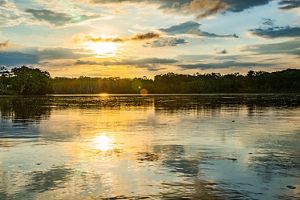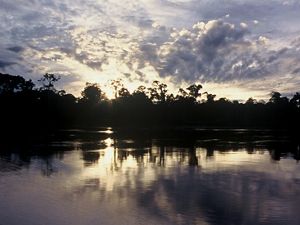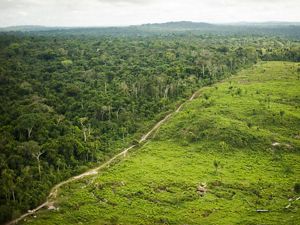Sustainable agriculture and ranching, honey production and other food production methods aim to strike a balance between environmental conservation and economic development, a crucial component for protecting the Amazon. Accounts from Colombia and Brazil.
Fabio Campiño has the lay of the land down. Out of his 106 hectares of farmland, 76 are grasslands. This area is divided into 26 pastures to support 300 head of cattle— something that is already yielding results, he says.
In a matter of seconds he rattles off another set of numbers about Cartagena del Chairá, Caquetá—one of Colombia's most dramatic deforestation hotspots. Between January and April 2020, the Colombian Amazon lost 75,031 hectares of forest. Out of these, 25,876 were in Caquetá. The municipalities of San Vicente del Caguán and Cartagena del Chairá lead the list with 11,740 and 10,365 hectares, respectively.
Extensive cattle production is one of the main causes of deforestation. Caquetá accounts for 7.9 percent of all cattle in the country, coming second only to Antioquia, according to figures from the Colombian Agricultural Institute.
It is nearly 4:00 p.m., time at which Fabio usually finishes his day, which begins with milking the cows around 5:00 a.m. and ends with daily chores such as dividing up the pastures.
He has done this as part of the Agroforestry for Conservation project implemented by The Nature Conservancy (TNC) and Amazon Conservation Team (ACT) in order to foster more varied and integrated use of the land. The goal is to drive economic development and environmental conservation in tandem.

Through agroforestry, Fabio has integrated a sustainable approach to his livestock operation. The aim: make the most of available pasture and eliminate the need to cut down more forest to accommodate or feed his cattle.
Presently, Fabio operates a rotation system in which cattle are kept on a pasture for one month and then moved to another while the previous one recovers. In this, he utilizes the land he has. By focusing on both conservation and productivity, it’s easier for Fabio to manage his cattle and he no longer has to lease grazing land elsewhere.
Before, it was all a single pasture, where the cattle roamed and wandered in search of water and shade—an unsustainable practice that degraded the soil. Now, productivity is higher and milk production has even increased.
A New Approach
Agroforestry systems combine food crops and native trees to nourish soils, capture carbon, sustain wildlife and ensure food security.
"They diversify people's livelihoods. If anything happens to livestock one season, there are the fruit trees. If one year something goes awry with cacao, then there are the cows or honey production, which creates a link to the forest that wasn't there before," explains María Fernanda Ordóñez, a TNC specialist.
Like Fabio, Gilma Hoyos, from San José del Fragua, Caquetá, no longer limits herself to raising cattle. She has been drawn to breeding native stingless bees, also known as meliponiculture. She started not long ago, she says, and it has become more appealing as it is not nearly as difficult as beekeeping: you don't have to be a specialist or dress like an astronaut, as you do when breeding stinging bees.
Quote: María Fernanda Ordóñez
[Agroforestry] creates a link to the forest that wasn't there before.
The bee option has not gone unnoticed. It also attracted Doña Graciela, from another part of San José del Fragua. "We didn't know that the bees were so diverse in our territory or how they were pollination pioneers. We just expected trees to bear fruit and had no idea that bees were the ones doing the work," she says.
Gilma says she is sticking with the agroforestry project, even though it is not always easy. Some families are still turning to illicit crops, another major cause of deforestation in Colombia, in addition to mining, legal and illegal logging, and drug trafficking.
But Gilma, Fabio, and Graciela are just some of the many people in the Amazon who are staking their bets on a change in the production process and inspiring others to adopt more sustainable practices. "You can see that you don't need as much land for it to work well," Gilma adds.

Going Beyond
Conserving the Amazon involves several countries. It is no small matter in Brazil, which as of 2018 had lost about 19.9 percent of its share of the Amazon to deforestation—moving toward the estimated tipping point of 20 to 25 percent forest loss. The underlying causes are analogous to those in Colombia: illegal logging, mining, and cattle operations.
That tipping point represents an unstoppable shift to a drier, savannah-like ecosystem, altering, among other things, rainfall cycles in a region that produces 70 percent of South America's GDP.
In a state like Pará, which accounts for 40 percent of the deforestation in the Brazilian Amazon, the focus is on public policy as a control mechanism to monitor deforestation-related activities and support sustainable economic development in local communities.
Quote
As of 2018 Brazil had lost about 19.9 percent of its share of the Amazon to deforestation—approaching the estimated tipping point toward a drier, savannah-like ecosystem.
Manoel Lemos, a cattle rancher, sees it as coming down to having the courage to open the doors of the farm, listen, and move from traditional systems to more sustainable ones, hand in hand with organizations like TNC. Hopefully, with positive outcomes, more people will follow. "As soon as productivity is up and profits come in, people embrace environmentally friendly practices and deliver a totally eco-friendly product," he says.
Support for Indigenous groups, the frontline custodians of the forest, is not far behind. In the state of Pará, for instance, a women-run enterprise is being implemented to help strengthen family incomes. The project focuses on babaçu coconut oil production for culinary and cosmetic use. The women are equipped with a new processing house and an oil extraction machine to streamline their operation and keep costs down. At the same time, marketing strategies have been created to help them connect directly with vendors.
Both in Caquetá and in Pará, where deforestation is highest in Colombia and Brazil, the challenge is to find balance and ensure wellbeing. "Conservation cannot be achieved without improving people's lives," concludes María Fernanda Ordóñez, a TNC specialist.
Originally published in Semana Sostenible (Spanish)
November 30, 2020
View Original
Global Insights
Check out our latest thinking and real-world solutions to some of the most complex challenges facing people and the planet today.



